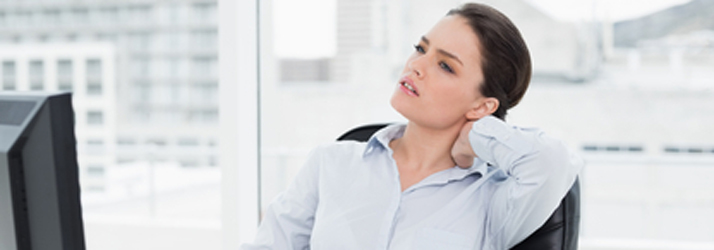Forward Neck Posture: What It Is And How To Fix It

Forward head posture, sometimes called “Scholar’s Neck”, “Text Neck”, or “Reading Neck”, refers to a posture where the head appears to be positioned in front of the body. It is a very common condition that I see in the office almost on a daily basis.
Technically speaking, forward head posture means that the skull is leaning forwards, more than an inch, over the atlas (which is the first vertebrae in your neck). Forward head posture is considered to be the most common postural deformity, affecting between 66% and 90% of the population.
With a few simple exercises, posture awareness and workstation modifications and you can start correcting this posture!
How to know if you have forward head posture?
- Stand with your back towards a wall with your heels positioned shoulder width apart
- Press your buttocks against the wall and ensure that your shoulder blades are in contact with the wall.
So, what’s the problem with this posture?
Forward head posture doesn’t just affect the neck and shoulders; the center of gravity of your entire body is also altered, which affects your torso and every joint in your body.
Your body tries to adapt to these positional changes be altering the balance control mechanisms of the body, which actually decreases your ability to balance when engaging in different activities throughout the day, and increases your risk of injury.
A study published in the Journal of Physical Therapy Science breaks down what happens to the body in individuals with forward head posture:
- The muscles and joints at the front of the neck become weak, while the muscles in the upper back and shoulders get really tight.
- The center of gravity of your head shifts forward (anteriorly), which increases the load on your neck (for every inch of forward movement, there is an extra 10 pounds of weight placed on your neck!). This can consequently lead to musculoskeletal, neural, and vascular system dysfunction.
- The changes that occur with forward head posture can lead to persistent and abnormal pressure in the muscles, tissues, and nerves of both the neck and shoulders, which can lead to rounding of shoulders(increased thoracic kyphosis) and herniated discs in an effort to compensate, which results in a higher load being placed on the back and shoulder muscles (Like Trapezius).
- When you combine all of these changes, you’ll eventually end up with a condition called “tension neck syndrome” – symptoms of this condition can mimic tension headache.
What are the symptoms of Forward Head Posture:
- Back pain
- Neck pain
- Muscle spasms
- Cervical (Neck) spine arthritis
- Restricted breathing
- Hyperkyphosis (Excessive rounded shoulders)
- Bulging Discs
- Herniated Discs
- Headaches and migraine
- Insomnia
- Numbness and tingling of the arms and hands
- Temporal mandibular joint (TMJ) pain
What causes Forward Head Posture?
Forward head posture is the result of a variety of factors, including:
- Poor posture
- Weakness of your neck muscles
- Previous neck strains or sprains
- Sleeping with your head elevated too high on pillows
- Frequently sleeping on a sofa with your head propped on the arm rest
- Extended computer use
- Extended cellphone use (“text neck”)
- Prolonged driving
- Incorrect breathing habits
- Carrying heavy backpacks
- Participating in sports that involve the dominant use of one side of the body (i.e. golf, tennis, hockey, baseball, etc.)
- Certain professions are more at risk due to repetitive movements of the body (i.e. hair stylists, massage therapists, writers, computer programmers, painters, etc.)
What is the treatment for Forward Head Posture?
Practicing good posture while performing your daily activities, combined with stretching and strengthening the muscles involved in forward head posture, can put you on the right path towards correcting this postural abnormality. Below, there are some good exercises that can help with forward head posture.
Neck Flexion (Suboccipital Stretch)
This will stretch the back of your neck muscles including the Suboccipital muscles.
- First, tuck your chin in using 2 fingers of one hand.
- Place your other hand on the back of your head and apply a gentle force down as you pull your head towards your chest.
- When you feel a stretch at the back of your neck, hold the position for 20 to 30 seconds.
- Repeat this stretch 3 times.
** Keep your chin tucked as you do this stretch
Chin Tuck Exercise
This exercise will activate and strengthen your deep cervical muscles (front of the neck muscles).
- Place 2 fingers at the bottom of your chin.
- Gently tuck your chin in and retract your head backwards. At the same time, use your fingers to keep the chin tucked in the entire time.
- Hold the end position for 3 to 5 seconds.
- Relax your neck for a moment (Let the neck come fwd).
- Aim for 2 to 3 sets of 10 repetitions.
** Your eyes should stay level and you should feel like the back of your neck is lengthening or “pulling up”.
Doorway Pectoralis Stretch
- Position your elbows and hands in line with a doorframe.
- Step through the door slowly, until you feel a stretch.
- Hold this end position for 15 to 20 seconds before returning to the starting position.
- Repeat this stretch 3 times.
Shoulder Blade Squeeze (aka Brugger’s Relief Position)
This exercise will activate and strengthen your low and mid back muscles.
- Position your feet and knees slightly wider than your hips and slightly rotated outwards.
- Maintain a chin tuck and raise your chest up, allowing your spine to be in a neutral position.
- Rest both of your arms down by your sides.
- Now bring your arms back and externally rotate them so that your thumbs are pointing backwards.
- Hold this position for 5-10 seconds and release.
- Aim for 2-3 sets of 10-15 repetitions.
* Breathe normally as you do these reps.
Lastly, Proper Ergonomics are very important when it comes to forward head posture. If you sit at a computer for extended periods of time, the single most important thing you can do to improve your workstation is to ensure that your computer monitor is positioned properly to allow your neck to remain in a neutral and relaxed position while you work.
- Ensure that the top third of your screen is at eye level
- Your monitor should be between 18 and 24 inches away from your face.
REFERENCES
McQuilkie, S., Joel, Kim, J., Ron, Turetsky, L., Ron, . . . Beth. (2019, March 14). How To Fix Forward Head Posture Fast - 5 Exercises And Stretches. Retrieved from https://backintelligence.com/how-to-fix-forward-head-posture/
Lee J. H. (2016). Effects of forward head posture on static and dynamic balance control. Journal of physical therapy science, 28(1), 274–277. doi:10.1589/jpts.28.274
OFFICE HOURS
Monday
9:00am - 6:00pm
Tuesday
2:00pm - 6:30pm
Wednesday
9:00am - 6:00pm
Thursday
2:00pm - 6:30pm
Friday
9:00am - 2:00pm
Saturday
Closed
Revival Health
9 Post Road Suite D3
Oakland, NJ 07436
Phone: (201) 485-7518
Fax: (201) 485-7517



